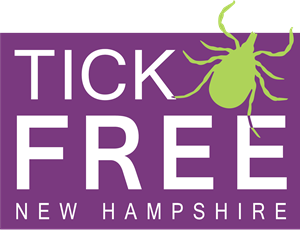Tick Free NH Partner Toolkit
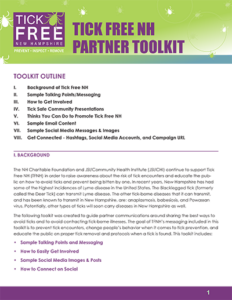 The following toolkit was created to guide partner communications around sharing the best ways to avoid ticks and to avoid contracting tick-borne illnesses. The goal of Tick Free NH’s messaging included in this toolkit is to prevent tick encounters, change people’s behavior when it comes to tick prevention, and educate the public on proper tick removal and protocols when a tick is found. This toolkit includes:
The following toolkit was created to guide partner communications around sharing the best ways to avoid ticks and to avoid contracting tick-borne illnesses. The goal of Tick Free NH’s messaging included in this toolkit is to prevent tick encounters, change people’s behavior when it comes to tick prevention, and educate the public on proper tick removal and protocols when a tick is found. This toolkit includes:
- Sample Social Media Messages & Images
- How to Connect on Social
- Sample Talking Points and Messaging
- Email/Newsletter Content
Download a full version of the Toolkit as a PDF with more actionable items and messaging.
Social Media Messages and Images
Feel free to use these co-brandable social media images on your social media or in newsletters. Two are provided for each topic area below – make sure to pair them with prevention messaging or the talking points found in this toolkit. [right click to download and save the graphic files for your use.]
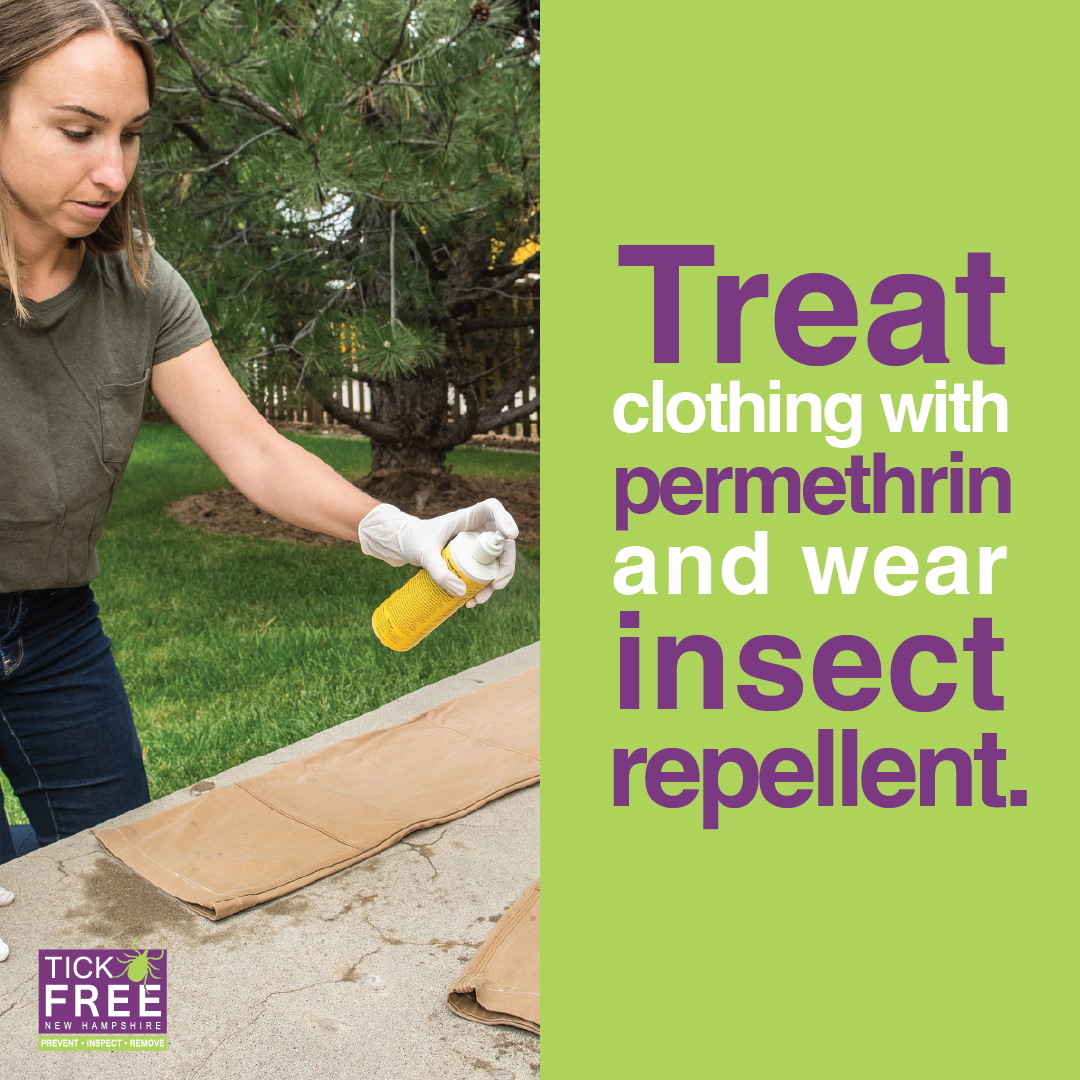
Ticks can carry bacteria and illnesses like Lyme disease, so prevention is important. Tucking long pants into socks, wearing long sleeves, and using insect repellent are easy ways to prevent ticks. Learn more at https://tickfreenh.org/prevent/

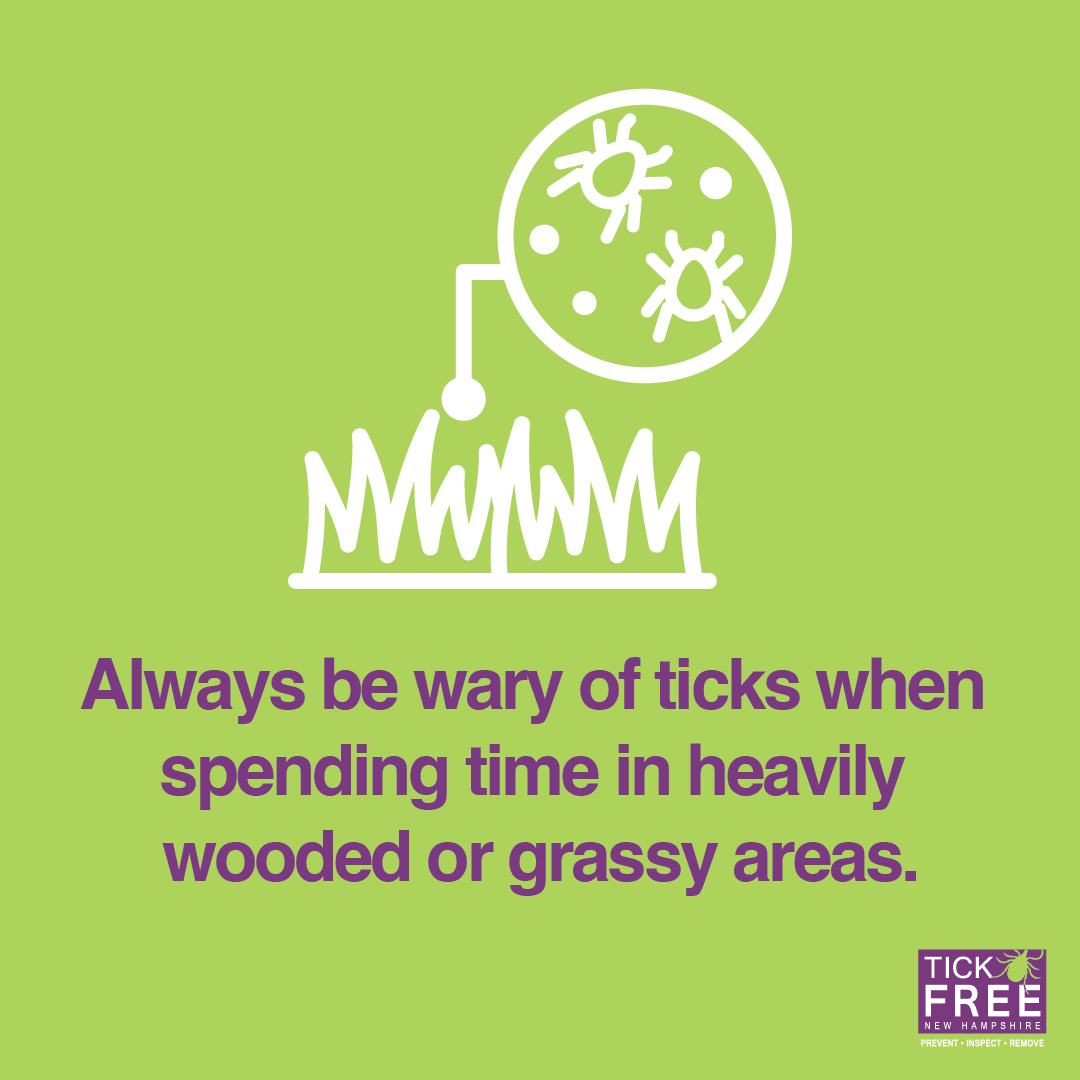
Avoid areas with lots of wood and brush where deer, rodents, and ticks are common. Always be weary of ticks when spending time in heavily wooded or grassy areas. Visit https://tickfreenh.org/protect/ to learn more!
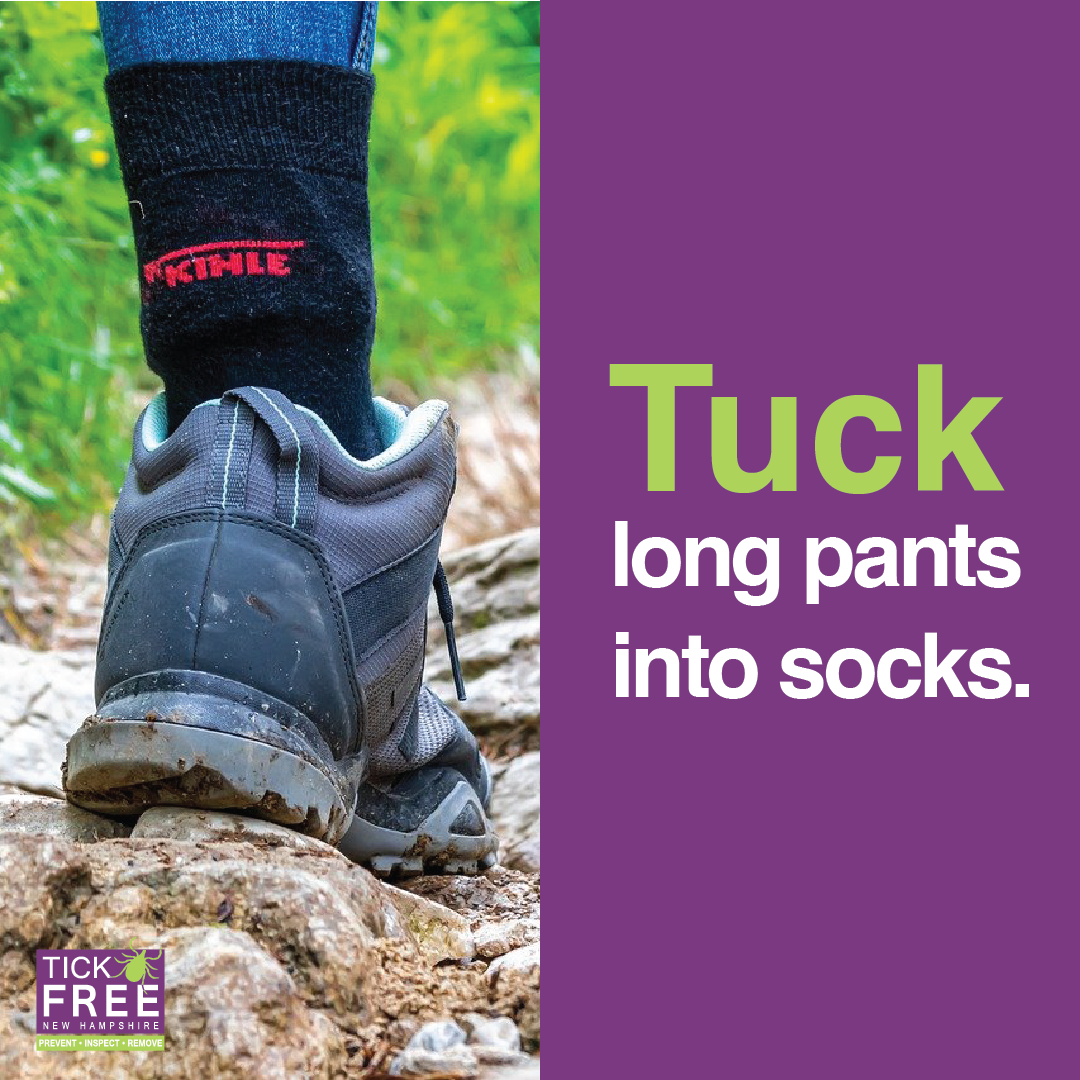
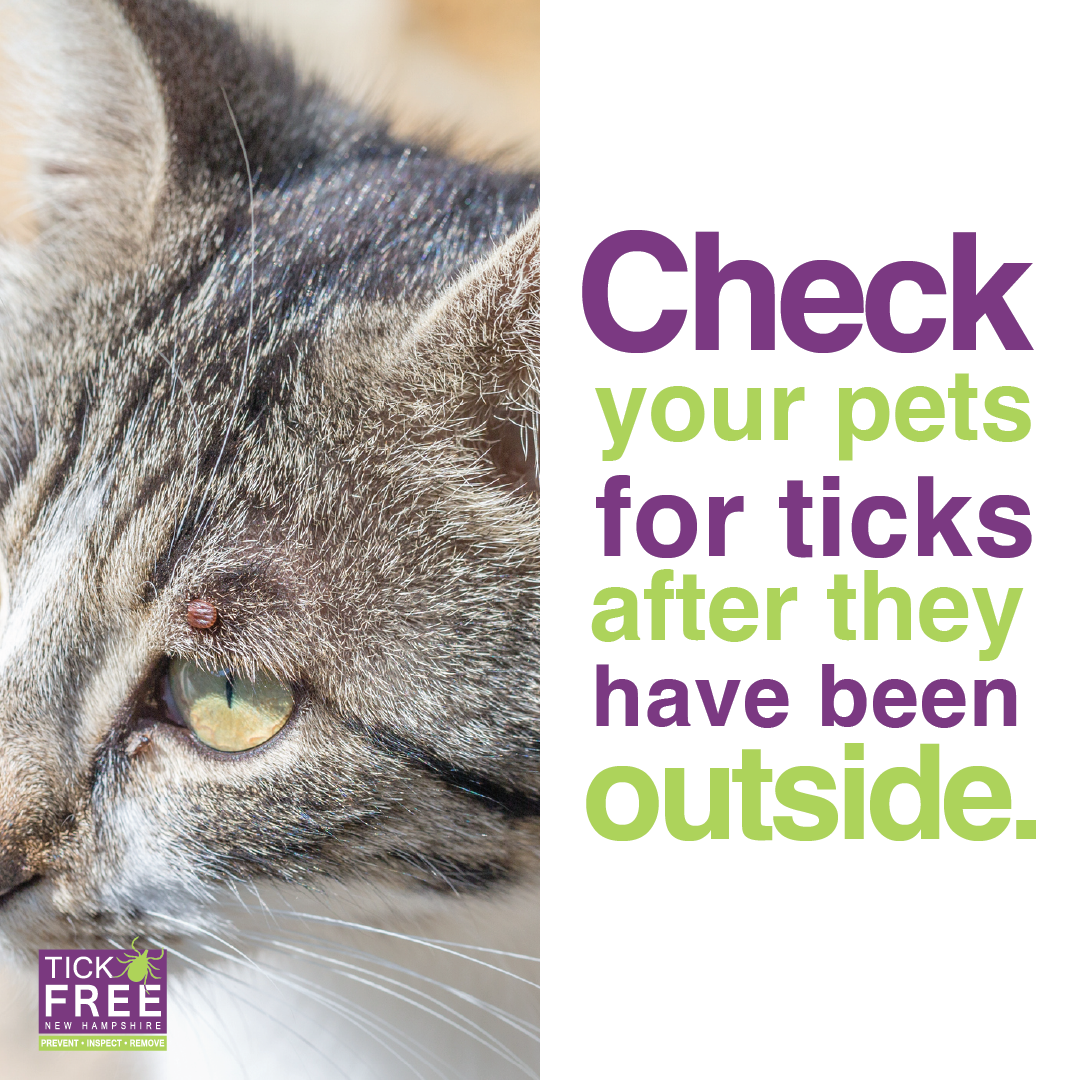
Make sure you check for ticks after spending time outside. Ticks can be brought indoors on shoes and clothing, too! Conduct a full-body check using a mirror, check kids and pets too! Learn more here: https://tickfreenh.org/check/
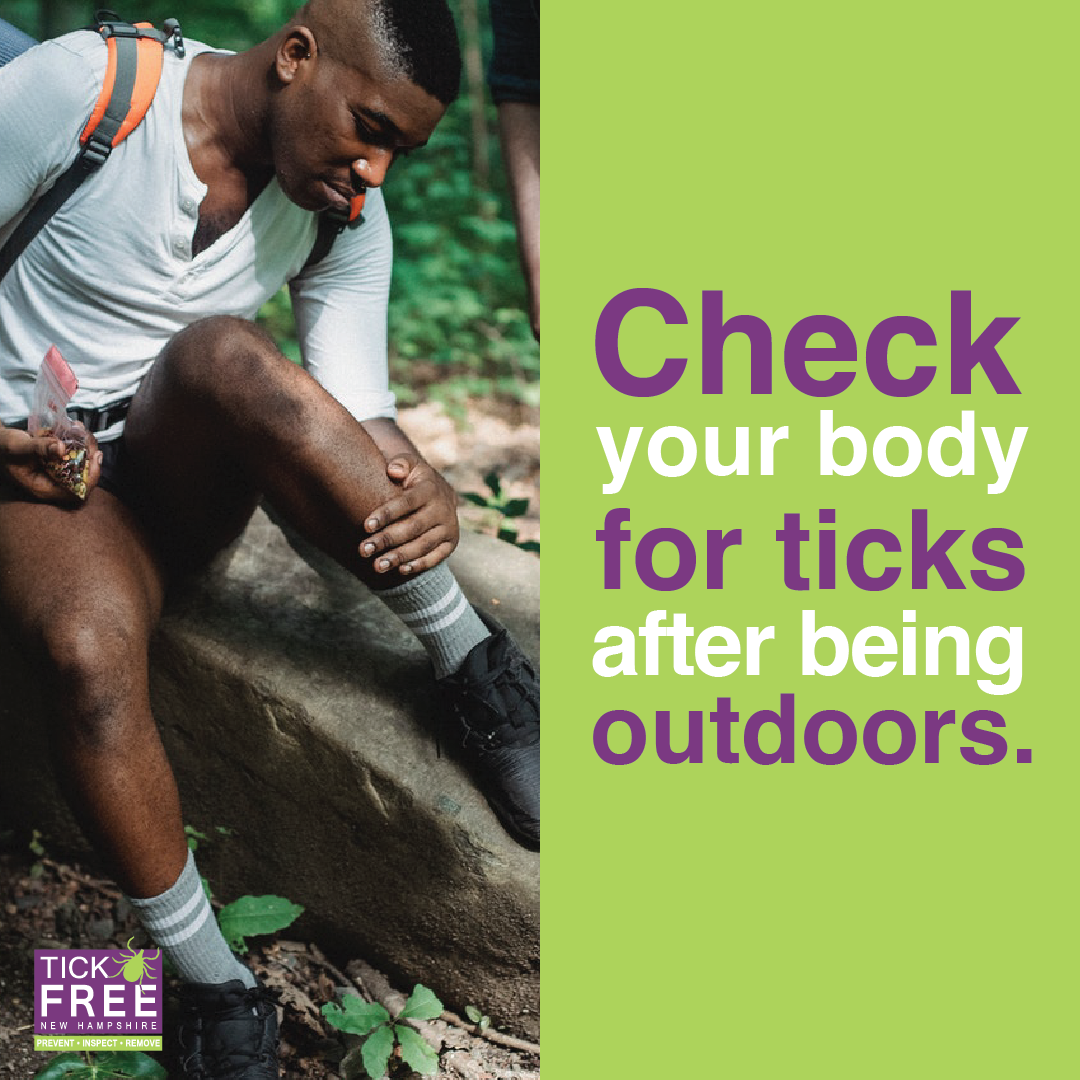
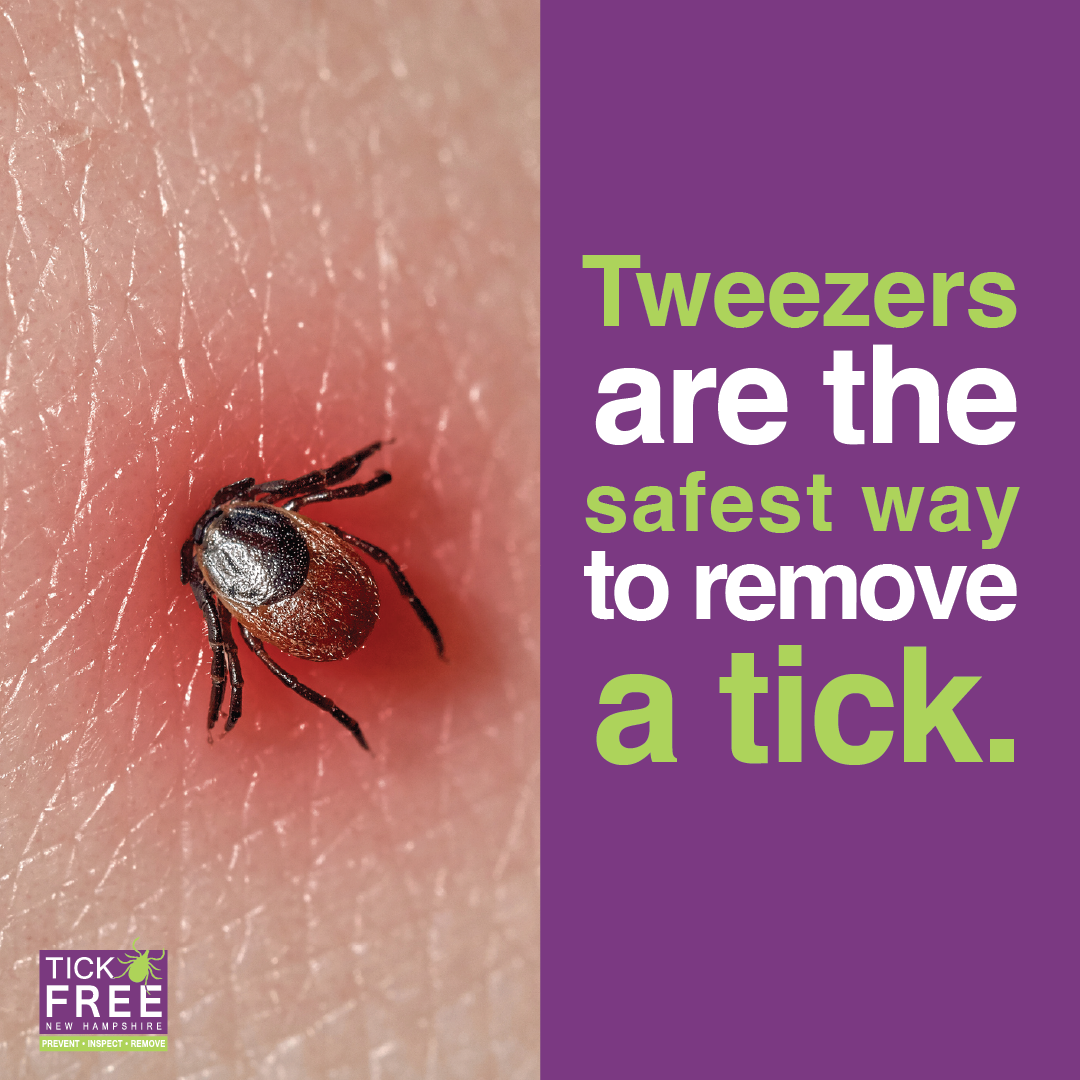
Did you find an attached tick? Remove it with tweezers by pulling straight up and save the tick in rubbing alcohol. Clean the wound with soap and water or rubbing alcohol. Contact your healthcare provider if you experience a bullseye rash, have any other concerns or identify the tick as the blacklegged tick. Learn more at https://tickfreenh.org/remove/
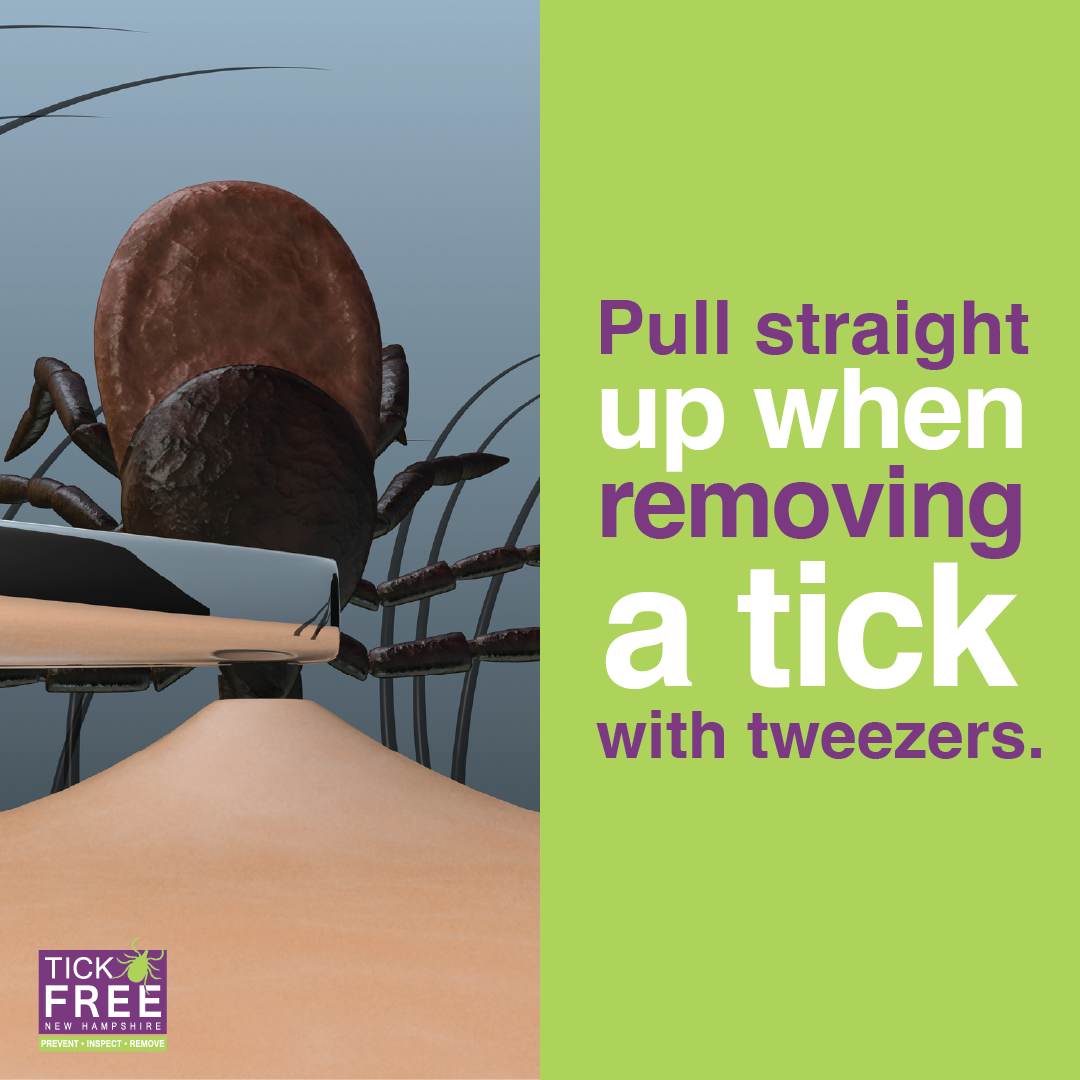
Did you find an attached tick? Remove it with tweezers by pulling straight up and save the tick in rubbing alcohol. Clean the wound with soap and water or rubbing alcohol. Contact your healthcare provider if you experience a bullseye rash, have any other concerns or identify the tick as the blacklegged tick. Learn more at https://tickfreenh.org/remove/
If you find an attached tick, use fine tipped tweezers to grab the tick’s head as close to the skin’s surface as possible for the safest removal. Learn more at https://tickfreenh.org/remove/
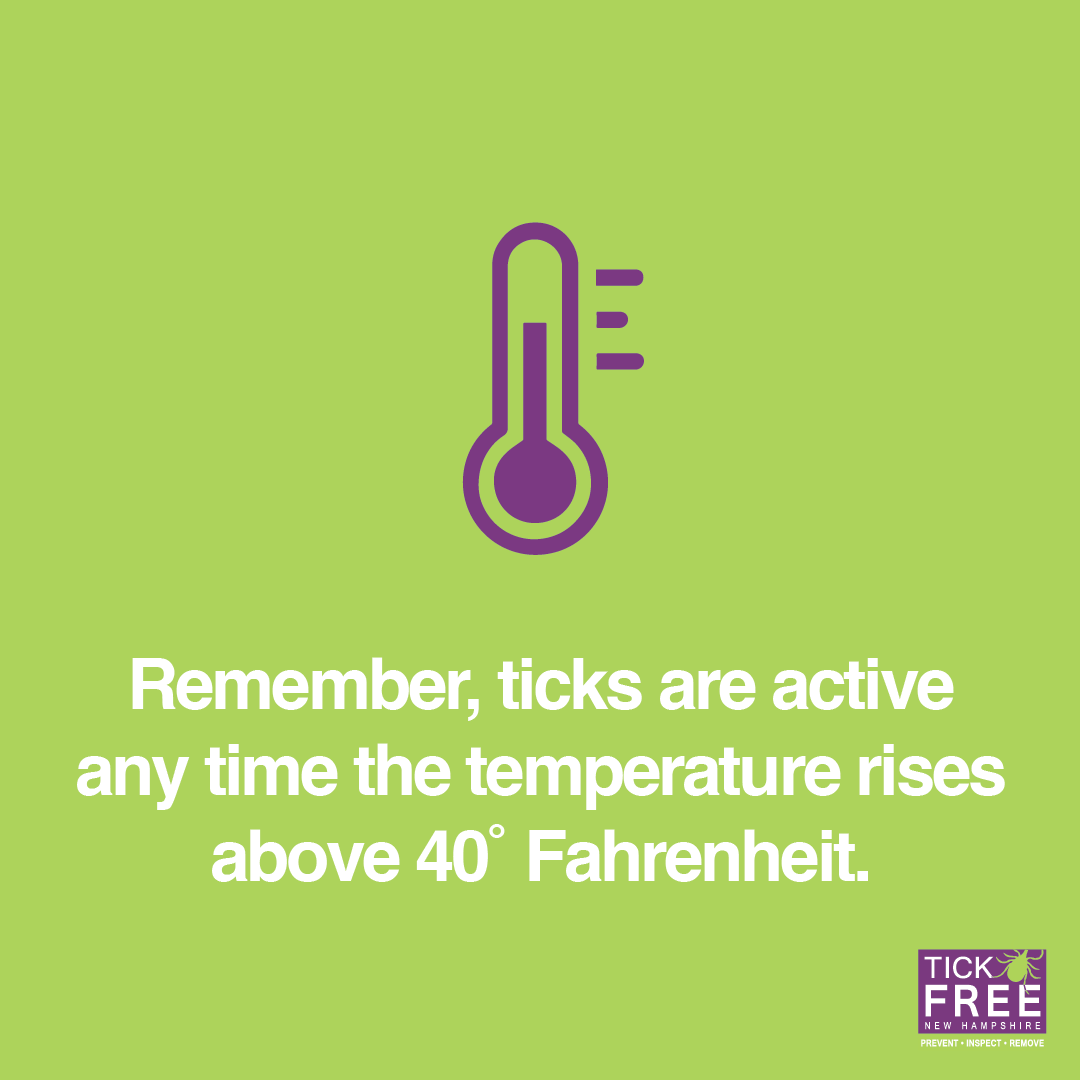
May Lyme Disease Prevention Month
Love the Granite State? We do too! Make sure you help raise awareness about tick safety this May for Lyme disease prevention month. Ticks are active any time the temperature rises above 40 degrees. Help fellow Granite Staters learn about proper removal techniques and prevention – the key to living tick-free! Learn more at https://tickfreenh.org/
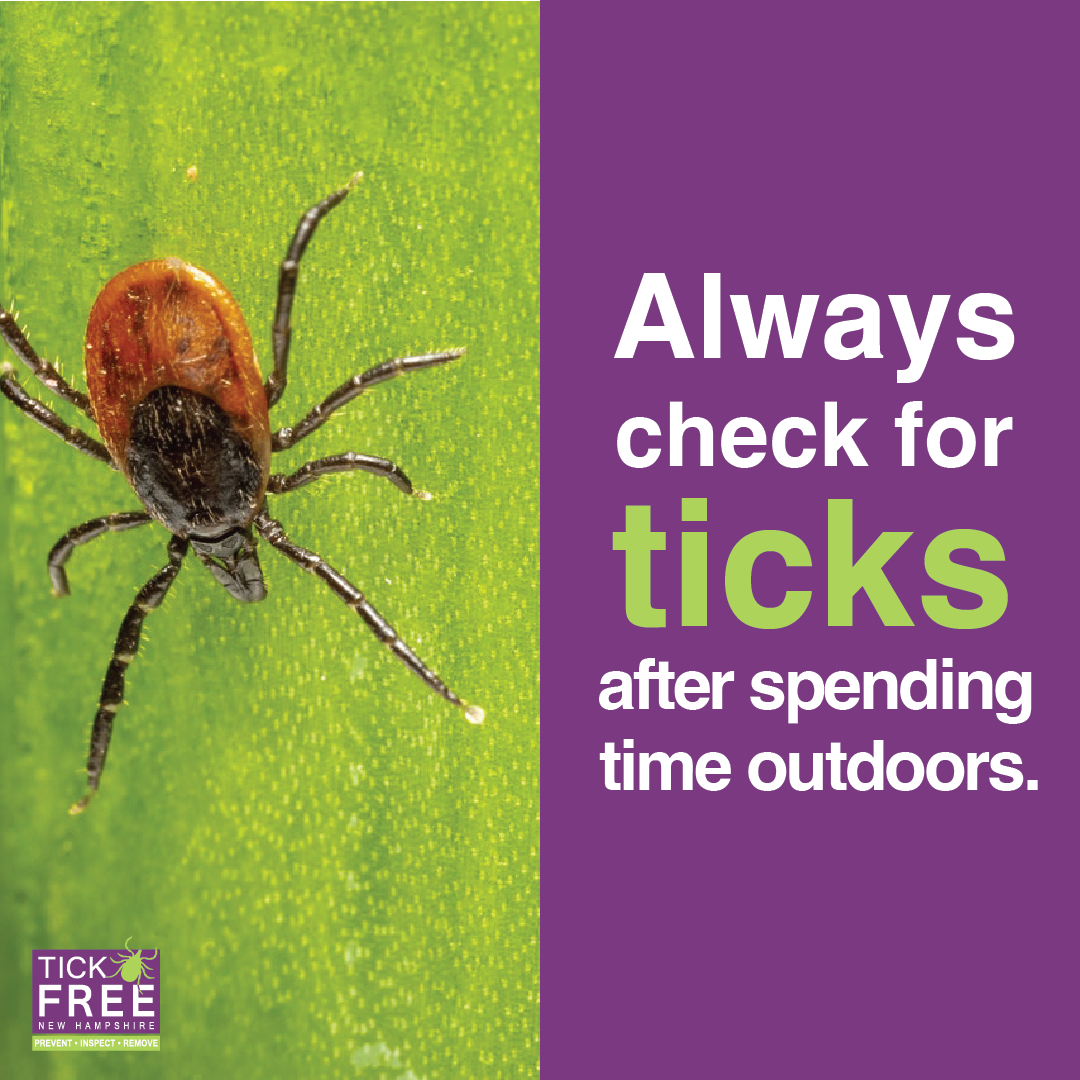
Help raise awareness about tick safety on Tick Bite Prevention Week. Ticks are active any time the temperature rises above 40 degrees. Help fellow Granite Staters learn about proper removal techniques and prevention – the key to living tick-free! Learn more at https://tickfreenh.org/
Get Connected – Hashtags and social media accounts
Like us, follow us and share our content! The current social media accounts for Tick Free NH include:
Instagram: @tickfreenh
Facebook: Tick Free NH
YouTube: Tick Free NH
You can use our current hashtags which include:
#TFNH
#TickFreeNH
By tagging us, we will know you mentioned us and like and share your posts too!
Talking Points & Messaging
These talking points can be used to begin a dialogue around tick prevention with people who live in New Hampshire and convey why it is important to protect ourselves and our homes. These points can begin a discussion among peers, inform tick protocols at a camp, or advise a person when they are unsure of what to do when they encounter a tick. The more informed you are, the better off you and those around you will be. They also double as messaging for social posts or short awareness blurbs.
Be Aware
- Everyone in New Hampshire is at risk of being bitten by a tick.
- Lyme disease is caused by bacteria carried by the Blacklegged tick. When a tick bites and embeds its head into a person or animal’s skin, it can transmit bacteria.
- You may come into contact with ticks during outdoor activities, around your home when gardening, when walking through leaf litter, or near shrubs.
- Children aged 2 to 13 are particularly at risk of picking up ticks around the home and contracting tick-borne illnesses like Lyme disease.
- Pets are just as susceptible to ticks as humans are, even a protected pet can carry a tick into your home.
Prevent
- Wearing tick repellent clothing, tucking long pants into socks, having long sleeves, using insect repellent, and staying to the center of paths is the best way for people to prevent tick bites when they venture outdoors.
- There are several ways to create a “Tick-Free Yard”. Some of these include: clearing tall grass and brushes from your lawn’s edge, placing play equipment, decks, and patios in direct sunlight instead of shade, and most importantly, maintaining your lawn with frequent mowing and keeping all leaves and debris raked.
Protect
- Wearing tick repellent clothing is the easiest and most effective way to prevent being bitten by a tick.
- Any of your favorite clothes can become trick-repellent clothing if they are treated with products containing Permethrin, an insecticide that kills ticks. This product can be sprayed onto items like boots, clothing, and camping gear and will continue to protect items through several washes.
- Permethrin should NEVER be applied directly to the skin and should only be used as directed on the product label.
- The best insect repellents contain 30% DEET, oil of lemon eucalyptus, or 20% picaridin. All of these products are safe as long as they are used as directed.
- Products containing 20% or more DEET can be applied directly to the skin and will last for several hours. However, each product is different so the directions on the individual product labels should be followed.
Check
- Check your body for ticks after being outdoors. Conduct a full-body check upon return from potentially tick-infested areas, this includes your backyard. Use a hand-held or full-length mirror to view all parts of your body.
- Putting clothing directly into the dryer on high for 10 minutes will kill ticks – the washer will not.
- It is important to conduct tick checks on your children as well. Ticks like to hide in places like: under the arms, in and around the ears, inside the belly button, on the back of the knees, in and around the hair, between the legs, and around the waist.
- Showering soon after being outdoors is an effective way to also remove ticks before they attach.
- If your pet spends a lot of time outdoors, a tick check should become part of your daily routine when it returns indoors.
Remove
- If you find a tick on your body, your children, or your pets it is important to remove it immediately. To properly remove an attached tick, use a plain set of fine-tipped tweezers or a tick removal scoop.
- Pull straight out – do not do anything to anger the tick – it may shoot bacteria into your body.
- Once removed, put into a “tape sandwich” or a small vial partially filled with rubbing alcohol.
You can easily incorporate some of this information in an email or newsletter to share the messages and resources with your audiences. We generally prioritize our audiences as falling into, but not limited to, one of these categories:
- NH residents (general)
- Caregivers of children ages 3-12
- NH Schools/Camps
- NH health care professionals
- At-risk workers and their employers
General Public
Example Language:
Ticks are now active! Be prepared. Did you know that as long as the ground isn’t frozen, ticks are active?
Order no-cost Tick Free NH materials now and remind your household or business to stay tick-aware this season! You can find information and more at TickFreeNH.org
Parents/Caregivers of Children
Example Language:
Tick season is still upon us – do you know about the free Tick Detective Workbooks available to New Hampshire families and childcare facilities? The workbooks are the perfect way to make sure that children know how to start to be tick-aware and the best ways to help prevent tick bites. Each workbook also comes with a free tick removal scoop! Find print-ables and learn more at https://tickfreenh.org/shareable-resources/.
Health Care Professionals
Example Language:
Looking for ways to easily engage patients or clients with tick prevention information before there is a tick bite? As a health care professional in New Hampshire, you can play a key role in reducing the spread of tick-borne diseases. The Tick Free NH Council and Tick Free NH provide NH health care professionals with resources on tick prevention to share with patients and encourage protective behaviors. Learn more about the free Health Care Practice Packet https://tickfreenh.org/product/tick-free-nh-health-care-practice-packets/
Classrooms, Camps & Childcare
Example Language:
Tick Free Campers are Happy Campers!
Have you ordered your Tick Free NH materials for the XXXX tick season yet? Most of our materials are available completely free of charge. Materials include: posters, tick ID wallet cards, Tick Detective Workbooks for grades K-4, tick scoops, and more! You can request materials and a presentation for staff or educate via the eLearning course at https://tickfreenh.org/tick-free-nh-schools/
Example Language:
Want to engage youth grades K-4 on tick prevention? Did you know about the free Tick Detective Workbooks available to New Hampshire schools & childcare facilities? The workbooks are the perfect way to make sure that children know how to start to be tick-aware and the best ways to help prevent tick bites. You can find print-ables, bulletin board modules and learn more at https://tickfreenh.org/tick-free-nh-schools/
For more information or feedback about this toolkit for partners, please Contact Us.
